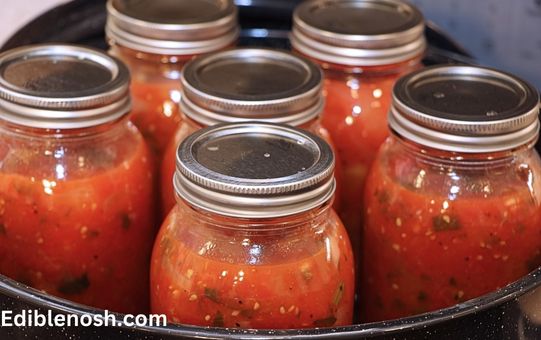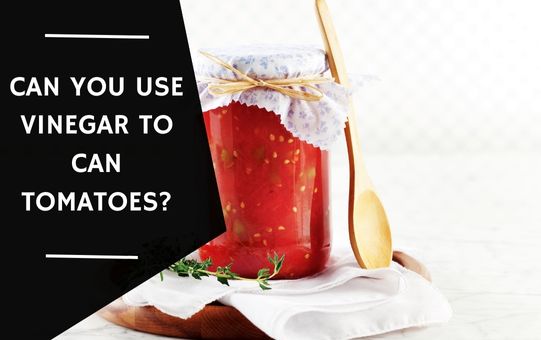If you’re looking for a natural way to preserve tomatoes, you may be wondering if can you use vinegar to can tomatoes. Learn the answer here!
Yes, vinegar can be safely used in the tomato canning process if proper canning techniques are followed and vinegar with at least 5% acidity is utilized. It can add flavor and increase acidity to prevent the growth of bacteria and spoilage.
This article examines the role of vinegar in the canning of tomatoes and whether or not it is a safe and effective method.
Contents
Why use vinegar to can tomatoes matter?
There are several reasons why using vinegar to can tomatoes can be beneficial. First, vinegar can add a tangy, acidic flavor to tomatoes, which some people prefer. Additionally, vinegar can help to enhance the color of the tomatoes and give them a brighter, more vibrant appearance.
Another reason to use vinegar in canning tomatoes is for safety. Tomatoes have a pH level that is slightly on the high side, which means they are not as acidic as some other types of fruits and vegetables. This can make them more prone to bacterial growth, which can lead to spoilage. By adding vinegar to the canning process, the acidity of the tomatoes is increased, which can help to inhibit the growth of bacteria and reduce the risk of spoilage.
It’s important to use vinegar with at least 5% acidity when canning tomatoes. This includes white vinegar, cider vinegar, and white wine vinegar. Do not use vinegar with lower acidity, as it may not be strong enough to prevent the growth of bacteria.
Read Also: Can You Use Crushed Tomatoes Instead Of Diced?
What is Canning?
Canning is a method of preserving food by storing it in airtight containers, typically glass jars. The food is first heated to a high temperature to kill any bacteria or other microorganisms, and then the jars are sealed to create a vacuum.
This vacuum helps to keep the food fresh and prevent it from spoiling. Canning is a popular way to preserve a variety of foods, including fruits, vegetables, meats, and more.

Why Use Vinegar in Canning?
There are a few reasons why some people choose to use vinegar when canning tomatoes. One reason is flavor. Vinegar can add a tangy, acidic flavor to the tomatoes, which some people prefer.
Additionally, vinegar can help to enhance the color of the tomatoes and give them a brighter, more vibrant appearance.
Another reason to use vinegar in canning is for safety. Tomatoes have a pH level that is slightly on the high side, which means they are not as acidic as some other types of fruits and vegetables.
This can make them more prone to bacterial growth, which can lead to spoilage. By adding vinegar to the canning process, the acidity of the tomatoes is increased, which can help to inhibit the growth of bacteria and reduce the risk of spoilage.
How to Use Vinegar in Canning Tomatoes?
If you want to use vinegar when canning tomatoes, here is a basic recipe to follow:
Ingredients:
- 4 cups of chopped tomatoes
- 2 tablespoons of vinegar
- 1 teaspoon of salt
Instructions:
- Sterilize the jars and lids by placing them in a pot of boiling water for at least 10 minutes.
- In a separate pot, combine the tomatoes, vinegar, and salt. Bring to a boil, then reduce the heat and simmer for 5 minutes.
- Using a ladle and a funnel, carefully fill the jars with the tomato mixture, leaving about 1/2 inch of headspace at the top.
- Wipe the rims of the jars with a clean, damp cloth to remove any dirt.
- Place the lids on the jars and screw on the rings until they are fingertip tight.
- Place the jars in a pot of boiling water and process for 45 minutes.
- Remove the jars from the water and let them cool completely.
- Check the seals on the jars. They should be concave and should not move when pressed. If the seal is not good on any of the jars, refrigerate the contents and use it within a few days.
Is it Safe to Use Vinegar in Canning Tomatoes?
So, can you use vinegar to can tomatoes? The answer is yes, but it’s important to follow safe canning practices to ensure that the finished product is safe to eat.
One thing to keep in mind is the type of vinegar that you use. It’s important to use vinegar that has at least 5% acidity. This includes white vinegar, cider vinegar, and white wine vinegar. Do not use vinegar that has a lower acidity, as it may not be strong enough to prevent the growth of bacteria.
It’s also important to follow proper canning techniques when using vinegar in the process. This includes sterilizing the jars and lids, heating the vinegar and tomatoes to the proper temperature, and sealing the jars properly.
If any of these steps are not done correctly, it can increase the risk of spoilage and food poisoning.
Tips for Canning Tomatoes with Vinegar
Here are a few tips for canning tomatoes with vinegar:
- Choose ripe, firm tomatoes for the best results. Soft or overripe tomatoes may not hold up as well during the canning process.
- Use vinegar with at least 5% acidity, such as white vinegar, cider vinegar, or white wine vinegar. Do not use vinegar with lower acidity.
- Follow a reliable recipe and pay attention to the proportions of vinegar to tomatoes. Using too much or too little vinegar can affect the flavor and safety of the finished product.
- Sterilize the jars and lids properly by boiling them for at least 10 minutes. This will help to kill any bacteria or microorganisms that may be present.
- Follow proper canning techniques, including heating the vinegar and tomatoes to the proper temperature and sealing the jars properly. This will help to reduce the risk of spoilage and food poisoning.
- If you are new to canning, it may be helpful to start with a smaller batch to get the hang of the process before tackling a larger quantity of tomatoes.
- Label and date the jars once they have been canned. This will help you to keep track of how long they have been stored and ensure that you use the oldest jars first.
By following these tips, you can enjoy the delicious taste and convenience of home-canned tomatoes with vinegar throughout the year. So, these are some of the tips which you can follow while canning tomatoes with vinegar.
Read Also: Can You Eat Sun-Dried Tomatoes From The Jar?
Final Thought
Vinegar can be used safely in the canning process for tomatoes as long as proper canning techniques are followed and vinegar with at least 5% acidity is used.
It can add flavor and help to enhance the color of the tomatoes, as well as increase their acidity to reduce the risk of bacterial growth and spoilage. Just be sure to follow a reliable recipe and take care to sterilize the jars and lids, heat the vinegar and tomatoes to the proper temperature, and seal the jars properly to ensure a safe and tasty finished product.
FAQs | Use Vinegar to Can Tomatoes
Following are the question related to using vinegar to can tomatoes:
Can You Use Vinegar To Can Tomatoes?
Yes, vinegar can be used safely in the canning process for tomatoes as long as proper canning techniques are followed and a vinegar with at least 5% acidity is used.
Why Use Vinegar When Canning Tomatoes?
There are a few reasons to use vinegar when canning tomatoes. It can add a tangy, acidic flavor to the tomatoes, enhance the color, and increase the acidity to help prevent bacterial growth and spoilage.
What Type Of Vinegar Should Be Used When Canning Tomatoes?
It’s important to use vinegar with at least 5% acidity when canning tomatoes. This includes white vinegar, cider vinegar, and white wine vinegar. Do not use vinegar with lower acidity, as it may not be strong enough to prevent the growth of bacteria.
Is It Safe To Use Vinegar In Canning Tomatoes?
Yes, as long as proper canning techniques are followed and vinegar with at least 5% acidity is used, it is safe to use vinegar in canning tomatoes.
How Do I Use Vinegar When Canning Tomatoes?
To use vinegar when canning tomatoes, follow a reliable recipe and pay attention to the proportions of vinegar to tomatoes. Sterilize the jars and lids, heat the vinegar and tomatoes to the proper temperature, and seal the jars properly.
If you are using a pressure canner, be sure to follow the manufacturer’s instructions carefully.

